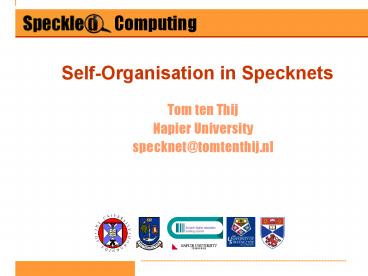SelfOrganisation in Specknets - PowerPoint PPT Presentation
1 / 13
Title:
SelfOrganisation in Specknets
Description:
Phallic-ness. Circularity. Path fork. Why this problem? ... else phallic. Speckled Computing. Optimization by evolutionary algorithms ... – PowerPoint PPT presentation
Number of Views:50
Avg rating:3.0/5.0
Title: SelfOrganisation in Specknets
1
Self-Organisation in Specknets
- Tom ten Thij
- Napier University
- specknet_at_tomtenthij.nl
2
Self-organisation
- Only localized interactions between elements
- Positive feedback loops can not be avoided
- Too large-scale for any form of global control
3
Amorphous Computing Project (MIT)
- Goal engineering of global structure in terms of
local unsynchronized interactions - Or engineering of emergent order
- Aimed at developing programming methodologies for
systems composed of vast numbers of identical
agents
4
A methodology gradient wave
- Source emit message with counter 0
- Recipients remember counter value and emit
message with increased counter - Messages with higher counter values are ignored
- Smoothing
Image source Amorphous computing project
5
Inspiration from fruit flies
- Morphogen gradients / Position
- Local inhibition
Images source The Interactive Fly
6
How to form a tube
- Assuming
- Gradient wave is only source of locational
information - Only local undirected interaction
- Two poles are established
- ?
Images source Amorphous computing project
7
Tube formation
- Phase 2
- - Gradient
- Phase 1
- Gradient
- Phase 3
- Form tube
- Phase 4
- Smooth
Images source Amorphous computing project
8
Tube formation movie
Movie source Amorphous computing project
9
Chosen problem topology feature detector
- Examples
- Phallic-ness
- Circularity
- Path fork
- Why this problem?
- Relatively simple but still hard to do
distributively - Many possible solutions can be envisioned
- Optimal solutions hard to design due to abundance
of interactions (chaos)
c
O
Y
10
Sketch of a solution for circularity detection
- Use local inhibition to define at least 2 sources
(a certain hop-count-distance apart) - Diffuse gradients from sources, other specks
propagating only first gradient that reaches them - A border is where to gradients meet. For every
border elect one b!speck using lateral inhibition - Each b!speck broadcasts its id over the network
so all specks can count the number of borders - If b!speck ? source ? circle
- else ? phallic
11
Optimization by evolutionary algorithms
- First hand design several property detectors
- Search space
- Parameters of packet propagation and state
transisions - Fitness
- Time before correctly detecting property
- Robustness of detection
- Hopefully optimisation that is hard to
hand-design can be found
12
The End
- Feedback / Questions?
13
References
- Amorphous computing
- http//www.swiss.ai.mit.edu/projects/amorphous/
- Radhika Nagpal. A Catalog of Biologically-Inspired
Primitives for Engineering Self-Organization. In
Engineering Self-Organising Systems, 2003. - The Interactive Fly
- http//www.sdbonline.org/fly/aimain/1aahome.htm































